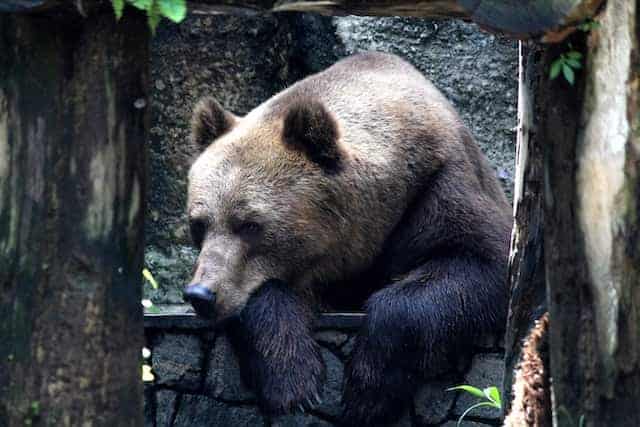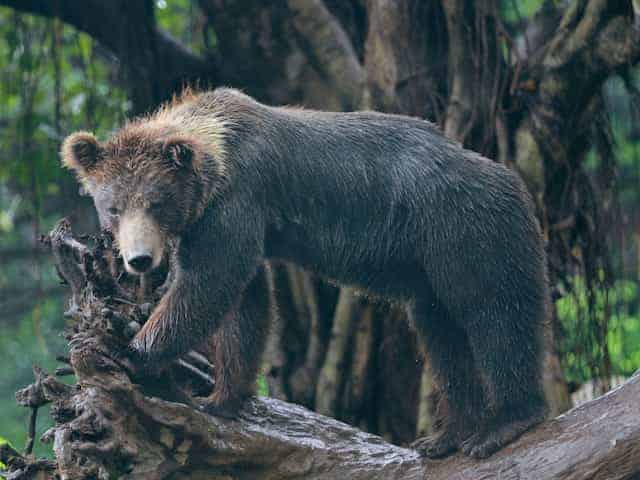In short, while bear attacks on hammocks are relatively rare, they can still happen. It’s essential to take proper precautions, such as choosing a safe campsite, managing food and scents, and knowing how to handle a bear encounter, to minimize the risk of a bear attack while hammock camping.
Let’s be honest: while we’re out there enjoying the wilderness, we can’t ignore the fact that bears share the same space. That’s why, in this comprehensive guide, I’ll be sharing crucial insights, tips, and advice to help you have a thrilling and safe hammock camping adventure, even in bear country.
We’ll dive into bear behavior, debunk myths about bear attacks, and discuss essential steps to bear-proof your campsite. So, grab your hammock and join me on this journey because together, we’ll ensure you can enjoy the great outdoors without compromising your safety.
Get to know your furry neighbors: Bear Behavior and Habitat

Before embarking on a hammock camping adventure in bear country, it’s essential to understand our furry neighbors a bit better. Being well-informed about bear behavior and habitat will empower you to make smarter decisions when setting up camp.
Types of bears and where they roam
In North America, there are three primary species of bears:
- Black bears: Widespread across the continent, these bears are found in forests, swamps, and even suburban areas. They are the most common species, with a population estimated at 600,000.
- Brown bears (including grizzly bears): More commonly found in the western part of the continent, they inhabit mountain ranges and coastal areas. There are around 55,000 grizzly bears in North America.
- Polar bears: Exclusive to the Arctic regions, polar bears are less likely to be encountered by campers. Their population is estimated to be around 22,000 to 31,000.
Unraveling the mysteries of bear behavior
Understanding bear behavior can help you predict and avoid potential encounters. Here’s a brief overview:
- Solitary creatures: Bears are generally solitary animals, except during mating season or when a mother is raising her cubs.
- Activity patterns: Bears are more active during dawn and dusk, known as the crepuscular hours. They may also be active during the day or night, depending on food availability and human activity in the area.
- Territorial: While bears are not strictly territorial, they do have home ranges where they travel, forage, and rest. Encroaching on their space could lead to unwanted encounters.
- Sense of smell: Bears have an extraordinary sense of smell, which they rely on to locate food. They can detect odors from miles away, and strong smells may attract them to your campsite.
Key factors that trigger bear encounters
Some common factors that may lead to bear encounters include:
- Odors from food, toiletries, or trash
- Camping near natural food sources like berry patches or fish spawning areas
- Surprising a bear at close range
Knowing these triggers will help you avoid situations that increase the chances of an encounter.
Bear attack hammocks: Fact or fiction?
Now that we know more about bears and their behavior, let’s explore the likelihood of a bear attacking a hammock camper and the risk factors involved.
While there have been a few documented cases of bears attacking hammock campers, these incidents are relatively rare. In one example, a camper in Wyoming had a black bear push him out of his hammock and tear apart his sleeping bag. However, it’s important to remember that such encounters are not the norm and can often be prevented by following proper safety protocols.
Decoding the risk factors behind bear attacks
Several factors can contribute to the risk of a bear attack:
- Food: Bears are often drawn to the smell of food, so it’s crucial to store it properly and cook away from your sleeping area.
- Noise: Making noise while hiking or camping can help alert bears to your presence, giving them time to move away.
- Proximity: Setting up camp too close to a bear’s territory or food sources can increase the chances of an encounter. Be cautious when selecting a campsite and avoid areas with visible signs of bear activity.
- Surprising a bear: If a bear is startled or feels threatened, it may become aggressive. Always be aware of your surroundings and give bears a wide berth.
Analyzing the odds of experiencing a bear attack
The odds of experiencing a bear attack while hammock camping are relatively low, particularly when compared to other outdoor risks such as hypothermia, dehydration, or getting lost. However, it’s essential to remain vigilant and follow proper safety protocols to minimize the chances of an encounter.
By understanding bear behavior and taking the necessary precautions, you can enjoy a thrilling and safe hammock camping adventure, even in bear country.
Bear-proofing your hammock camping adventure

Selecting a strategic and safe camping location
1. Steering clear of bear hotspots
It’s essential to avoid bear hotspots when choosing your hammock camping location. Bears are more likely to be found near water sources, berry patches, or areas with high levels of insect activity. Make sure to research your intended camping area and select a site away from these attractions.
2. Assessing food sources and bear travel corridors
Bears often follow specific travel corridors as they search for food. When setting up camp, avoid areas with signs of bear activity, such as fresh tracks, scat, or claw marks on trees. Camp at least 100 yards away from food sources, like berry patches or carcasses, and water sources.
3. The power of numbers: Camping in groups
Bears are less likely to approach a group of people than a single individual. Camping in groups not only increases safety but also provides a more enjoyable experience. Make sure to maintain a unified presence by cooking, eating, and storing food together.
Mastering the art of bear-safe food handling
1. Fortifying your campsite with bear-resistant containers
Bear-resistant containers are designed to keep your food safe from curious bears. Using these containers not only protects your food but also prevents bears from becoming accustomed to human food, which can lead to dangerous behavior. Be sure to store all food, toiletries, and scented items in bear-resistant containers.
2. Designating separate cooking and sleeping zones
Cooking and eating should always take place at least 100 yards away from your sleeping area to minimize the chances of attracting bears. Establish separate cooking, eating, and sleeping zones, ensuring that any food odors remain far from where you sleep.
3. Leaving no trace: Thorough cleanup practices
Maintaining a clean campsite is crucial in preventing bear encounters. Thoroughly clean all cooking utensils, dishes, and surfaces, and store food scraps and trash in bear-resistant containers. By leaving no trace, you reduce the likelihood of bears associating humans with food.
Neutralizing odors and reducing bear attractants
1. Sealing in scents with odor-proof containers
Odor-proof containers help seal in scents that may attract bears, such as food or toiletries. Invest in high-quality odor-proof bags or containers and store them alongside your bear-resistant containers.
2. Responsible trash and waste management
Properly managing trash and waste is critical to avoid attracting bears. Dispose of trash in designated bear-proof receptacles, or pack it out with you. For human waste, dig a cat hole 6-8 inches deep and at least 200 feet away from water sources, trails, and your campsite.
3. Maintaining personal hygiene without luring bears
Maintain personal hygiene by washing your hands, face, and body away from your sleeping area. Use unscented or biodegradable soap and water to clean up, and store any scented personal items like deodorant or toothpaste in bear-resistant containers.
Hammock camping tips for added peace of mind in bear country
1. Choosing a bear-resistant hammock setup
Selecting a hammock setup with built-in features to deter bears can provide an extra layer of security. Look for hammocks with bug nets and rainfly covers that can be zipped closed. While this won’t necessarily stop a determined bear, it can make you less visible and reduce the chances of a curious bear investigating your sleeping quarters.
2. Educate yourself on local bear activity
Before setting out on your hammock camping adventure, research the area’s bear activity. Check with local park rangers or wildlife authorities to learn about recent bear sightings or incidents, and ask for advice on the best practices for camping safely in the area. Knowledge is power, and being informed about local bear activity can help you make better decisions while hammock camping.
3. Develop a bear encounter action plan
Prepare for the unlikely event of a bear encounter by creating an action plan with your camping partners. Discuss what each person should do if a bear approaches the campsite, and make sure everyone knows their roles and responsibilities. Having a plan in place can help reduce panic and ensure a more coordinated response if a bear does show up.
4. Hammock camping etiquette in bear country
Finally, practicing good hammock camping etiquette can help keep both you and the bears safe. Follow these guidelines:
- Respect wildlife: Keep a safe distance from bears and other wildlife, and never attempt to feed them. Remember that you’re a visitor in their home.
- Leave no trace: Clean up your campsite and pack out all trash, leftover food, and litter to reduce the chances of attracting bears.
- Follow park regulations: Adhere to any rules and regulations in the area you’re camping, such as using designated camping sites or bear-resistant food storage.
Face-to-face with a bear: How to handle a bear encounter

Distinguishing bear species and their reactions
Before we delve into how to handle a bear encounter, it’s important to understand the differences between bear species and their behaviors. Here’s a table to help you distinguish between the three most common bear species found in North America:
| Species | Size | Color | Behavior |
|---|---|---|---|
| Black Bear | 4-7 feet | Black, brown, cinnamon, white | More timid, may climb trees |
| Grizzly Bear | 6-9 feet | Brown with grizzled fur | More aggressive, may bluff charge |
| Polar Bear | 8-11 feet | White | Highly aggressive, predatory |
Black bears are generally more timid and might climb trees to escape a perceived threat. Grizzly bears are larger and can be more aggressive, often displaying bluff charges to intimidate potential threats. Polar bears are the largest and most dangerous, as they are highly aggressive and predatory by nature.
Understanding the species you may encounter in your camping location will help you be better prepared to handle any potential encounters appropriately.
Staying calm and collected during a bear sighting
1. Announcing your presence confidently
If you spot a bear in the distance, make sure to announce your presence confidently. Speak loudly and clearly, and avoid screaming or making high-pitched noises. This will help the bear identify you as a human and not a potential threat or prey.
2. Communicating with bears: Speaking calmly and firmly
While communicating with a bear, use a calm and firm tone. This will show the bear that you are not a threat, but also not submissive. Keep your voice steady and maintain eye contact without staring too intently, as this can be perceived as aggressive.
3. Avoiding signs of aggression or submission
During a bear encounter, avoid displaying signs of aggression or submission. Do not run or turn your back on the bear, as this can trigger a chase response. Instead, stand your ground and slowly wave your arms to appear larger. If the bear approaches, slowly back away without turning your back to the bear.
Surviving a bear charge or attack
1. Unleashing the potency of bear spray
Bear spray is a powerful deterrent that can be highly effective in stopping a bear attack. If a bear charges or attacks, aim the bear spray at the bear’s face and discharge the canister. The capsaicin in the spray will irritate the bear’s eyes, nose, and throat, potentially deterring it from continuing the attack.
2. The ultimate showdown: Playing dead vs. fighting back
If a bear makes contact, your response should depend on the species. If it’s a grizzly bear, playing dead may be your best option. Lie face down, cover your neck with your hands, and spread your legs to make it harder for the bear to flip you over. Remain as still as possible until the bear leaves.
If it’s a black bear or a polar bear, fighting back may be necessary. Focus on striking the bear’s nose, eyes, or ears, and use any available objects like rocks or branches as weapons. Remember that your goal is to convince the bear that you are not worth the trouble, so fight with everything you’ve got.
Frequently Asked Questions (FAQ)
1. Are you more likely to be attacked by a bear in a hammock compared to a tent? No concrete evidence suggests that bears are more attracted to hammocks than tents. The key to minimizing encounters is following proper camping practices, such as safe food storage and odor management.
3. Do bears actively seek out human interaction? No, bears generally avoid humans and only approach campsites when attracted by food, trash, or other scents. Follow safe camping practices to minimize your chances of attracting bears to your site.
4. Can I cook near my hammock if I’m careful and clean up afterward? It’s best to designate separate cooking and sleeping zones, keeping them at least 100 yards apart. Cooking near your hammock increases the risk of attracting bears with food odors.
5. How do I know if I’m setting up camp in a bear hotspot? Research your camping area beforehand to learn about local bear populations and their typical habitats. Avoid setting up camp near trails, berry patches, or other known food sources for bears.
6. Is it safe to sleep with food in my hammock? No, always store food and other scented items in bear-resistant containers or hang them from a tree at least 100 yards from your sleeping area. Storing food in your hammock increases the risk of attracting bears. My only request is to respect the life of trees by setting your hammock so that it does not harm trees.
7. What should I do if I encounter a bear while hammock camping? Remain calm, speak in a firm but calm voice, and avoid direct eye contact. Slowly back away without turning your back on the bear. Do not run or make sudden movements, as this could trigger an attack.
8. Can I use my hammock as a barrier between me and the bear during an encounter? Using your hammock as a barrier is not recommended, as it could provoke the bear or cause it to become entangled. Follow the appropriate steps for handling bear encounters to ensure your safety.

Michael is heavily inclined towards traveling to natural places and documenting cultures/people from different parts of the world. He also loves hiking and camping and is spirited toward all outdoor activities. He will share his passion for outdoor life and brands or products we use outside our homes. He has good research skills, and that’s why you can see why his articles are packed with info that is factual and not readily available. He also has the vision to travel the whole world and share it with all readers of Outdoor Favor.
